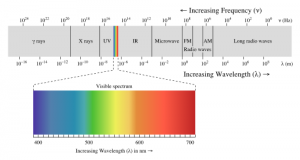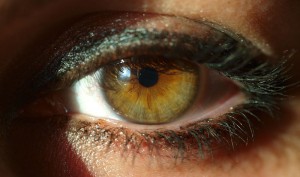I was having an interesting discussion with a friend the other day about art. The discussion, as most of ours do, ended in a flurry of quick and dry witted retorts. But before our diatribe came to a head, a question was posed. As an engineer, I was poised to present a plausible, and elegant answer.
The question: Why do people see art differently?
There’s a multitude of explanations, ranging from psychological to socio-economic, but those explanations are messy. I proposed a rather mundane approach to attempting to answer this question.
For my reasoning, let’s start with light.
Visible light is a very narrow band on the spectrum of electromagnetic radiation situated between Infrared and Ultraviolet radiation. Visible light is estimated to be less than one percent of the entire electromagnetic spectrum. My reasoning focuses more on how our eyes perceive light and our brain processes the information, rather than the radiation itself. Our human eyeballs have cells, called cones, with which we perceive color. We see items as a certain color because the pigments in those items reflect those particular components of the visible spectrum and absorb all others. For example, we see red apples as red because the pigments present reflect only the red components or wavelengths, of white or visible light. Now some of you may already know where I’m going with this, but for those of you that need a hint, a quick internet search of “Colorblind” will net “about 3,790,000 results”, thank you Google. Adding the keyword “statistics” will give you another “361,000”.
The general consensus is 7 to 10 percent of the male population has some form of color blindness, which is actually more properly described as color vision deficiency. Now, the color vision deficiency genetic markers are both, recessive traits ,and linked to X-chromosomes. The combination of these two properties, with some cool biology charts and math, mean that less than .4 percent of the female population, by most calculations, has a color vision deficiency. Daughters are likely to inherit the recessive genes from parents, but thanks to more cool biology, math, and charts, both parents would have to exhibit a color vision deficiency for a daughter to have color vision deficiency, whereas a son can exhibit a color vision deficiency where both parents lack one. As you can see, with .4 percent of female population being color vision deficient if you iterate the situation it becomes less likely the longer you look at it. While these percentages are not alarmingly large, they are such that it is highly likely that you are acquainted with a person who has a color vision deficiency.
It has been conclusively proven, that as human individuals we are all different in some way shape or form. An easy answer would be that since we are all individuals it would be in our individual nature, to have a distinctly individual interpretation of art. As a human, I, of course, made this assumption.
However, as an engineer, I made a metric.
For a 6,973,738,433 world population we factor in a color vision deficiency modifier. Using [(7+10)/2] +.4 = 8.9 percent, as rough average of color vision deficiency on a world scale, we have a modified world population of 6,973,738,433 x (1 – .089) = 6353075712.46. This rounds to 6353075713 people, but for the sake of being rigorous we will keep it as a decimal. On average there are 4.5 million cone cells per human eyeball. The wavelength of Red visible light is 750 to 620 nanometers (a range of 130nm). We chose red wavelength because it is the largest ranged wavelength in the visible spectrum and because the majority of color vision deficiency is in the perception of the colors red and green.
I submit to you that the reason why people see art differently is that, according to my calculations, there exist [6353075712.46 x (4,500,000 x 2)] / 130 = 4.398 x 1014 possible personal cellular per nano meter (pc/nm) interpretations of the color red.
The next time you’re enjoying looking at some works of art, try counting how many different personal cellular interpretations of the color red you see!
Are you color vision deficient?
References:
https://science.hq.nasa.gov/kids/imagers/ems/visible.html
https://missionscience.nasa.gov/ems/09_visiblelight.html
https://en.wikipedia.org/wiki/Visible_light
https://en.wikipedia.org/wiki/Visible_spectrum
https://en.wikipedia.org/wiki/Eye
https://www.toledo-bend.com/colorblind/Ishihara.asp




